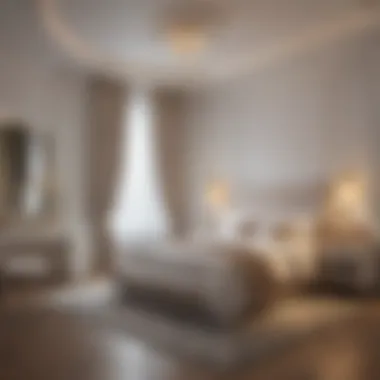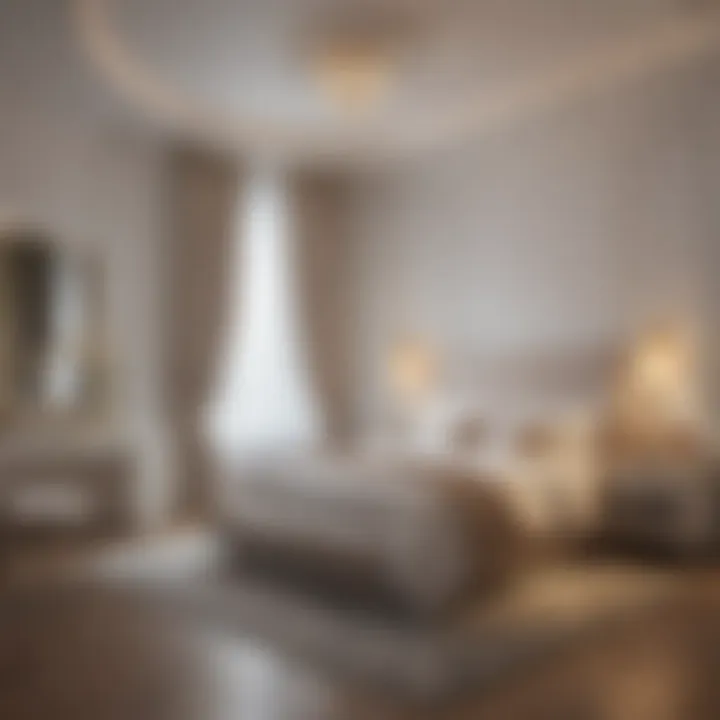Effective Strategies for Creating Spacious Small Bedrooms


Intro
In the world of interior design, size can often feel like a limiting factor. For homeowners, particularly in urban settings where space is at a premium, transforming a small bedroom into a haven of comfort while also maintaining a sense of openness is a critical challenge. Fortunately, there are countless strategies at our disposal to visually expand the space and make it feel more inviting.
The key to achieving this involves a harmonious blend of design inspirations, functional elements, and a keen eye for detail. This article delves into effective methods such as selecting the right color palettes, utilizing smart furniture choices, and employing precise spatial organization techniques. By the time you finish reading, you'll have gathered a wealth of actionable insights tailored for those seeking to optimize their bedroom environments.
Design Inspirations
Latest Trends in Bedroom Design
When it comes to bedroom design, trends can rapidly change. However, certain principles remain timeless. Using sleek lines and minimalistic designs can help create an illusion of more space. For instance, opting for platform beds or wall-mounted shelves can free up floor area, allowing air to circulate more freely. Many modern homeowners lean towards Scandinavian aesthetics, known for its simplicity and functionality. This style encourages the use of natural materials and neutral colors, promoting a serene atmosphere.
Moreover, integrating mirrors as decorative elements can give a delightful sense of depth and amplifies the light within the room. This is not merely about replicating what’s currently in vogue. It’s about creating an environment that reflects personal taste while also making the most of spatial limitations.
Color Palettes and Themes
Color plays a pivotal role when it comes to making spaces appear larger. Lighter shades such as soft whites, pale blues, and gentle grays can instill a sense of calm and openness. On the other hand, darker colors, if used sparingly, can add drama and dimension. The trick lies in balancing these tones properly.
An effective strategy is to employ a monochromatic scheme. This means varying shades of the same color throughout various design elements. For instance, a room painted in a light blue could feature darker blue bedding, curtains, and artwork harmoniously tied together. Accent walls, if chosen correctly, can provide a focal point without overwhelming the senses.
"Utilizing color effectively can deeply impact how we perceive any space, particularly when it comes to confined areas."
Functional Elements
Space Optimization Tips
In small bedrooms, every inch counts. Start by decluttering your space. It’s easy for items to accumulate and create an uninviting atmosphere. Consider adopting a minimalist approach; you’ll be amazed at how clearing away excess can provide more breathing room.
Further, vertical storage solutions can be a game changer. Consider adding shelves above beds or dressers. Not only does this utilize wall space, but it also keeps necessary items within reach. Baskets and decorative boxes can also help in maintaining a tidy appearance while making use of often-overlooked nooks.
Multi-Functional Furniture Choices
Investing in furniture that serves multiple purposes can revolutionize how you perceive your bedroom's functionality. Beds that double as storage units, foldable desks, or ottomans that open up for extra seating are all stellar examples. These options can significantly reduce clutter while offering practicality in smaller spaces.
Moreover, consider designs that allow for
Understanding Perception of Space
Understanding how we perceive space is crucial when designing small bedrooms. It goes beyond mere measurements and dimensions; it's about how we feel within that space. The way a room appears can significantly influence our comfort and functionality. For instance, a cramped layout might evoke feelings of anxiety or confinement, while an open feel can create an atmosphere of calm and relaxation.
In this regard, the perception of space encompasses elements like color, light, texture, and arrangement. Each plays a pivotal role in crafting how expansive or claustrophobic a room feels. Therefore, harnessing these elements effectively can lead to a room that not only provides shelter but also becomes a retreat for its inhabitants.
The benefits of mastering space perception are manifold. Firstly, it enables a more efficient use of small areas, which is increasingly pertinent in modern living where real estate can be pricey. It can transform a small bedroom into a versatile haven that meets various needs, from resting to working or simply unwinding after a long day.
The Psychology of Space
The psychology of space delves into how we mentally interpret our environment. When you enter a small bedroom, your initial reaction can be almost subconscious. If it feels cramped, you might immediately feel unsettled. According to various studies in spatial psychology, open spaces often evoke feelings of freedom and creativity, while smaller spaces can influence mood and behavior in ways we may not even recognize.
It's fascinating to note that even the arrangement of furniture plays an essential role. For example, furniture placed out of the line of sight can create a sense of depth and distance. People often feel more relaxed in spaces that allow for movement and flow rather than tight lines and rigid setups. This psychological aspect makes it essential to consider how one's perception affects overall satisfaction and well-being within the space.
Visual Tricks to Create Space
Utilizing visual tricks can significantly alter the feeling of space in a small bedroom. Architects and designers frequently employ various techniques that modify eye perception, allowing inhabitants to experience a more expansive environment.
- Layering Textures: Different textures draw the eye in various directions. For instance, combining smooth, reflective surfaces with soft fabrics can create a layered look that adds depth.
- Vertical Lines: Incorporating vertical lines through wallpapers or furniture design can lead the eye upward, making ceilings feel higher. This strategy can be particularly effective when opting for tall bookcases or using slim, vertical artwork.
- Focal Points: Creating a focal point within the room—like a bold piece of art or an interesting headboard—can also help distract from the room’s size. When someone focuses on the focal point, they may overlook other spatial constraints.
"The art of illusion is key in small spaces. The goal is to forge a psychological trickery that persuades the mind into believing that there is more air in the room than there truly is."
These tricks are not merely superficial; they are grounded in the science of how we see and process our environments. By incorporating these visual elements into a small bedroom design, you invite not just aesthetics but a sense of serenity.
Color Choices for Illusion of Space
Color plays a crucial role in shaping our perception of space, especially in small bedrooms. It’s not just a matter of aesthetics; the right color choices can actually make a compact room feel more expansive and airy. From light hues that reflect natural light to the strategic use of darker shades, understanding color theory is key to transforming limited square footage into a more welcoming environment.


Light Colors vs. Dark Colors
When it comes to creating an illusion of space, light colors hold a significant advantage. Subtle shades of whites, beiges, and pastel hues bounce light around the room, making it feel bright and open. A light-colored ceiling can raise the perceived height of the room, while walls painted in soft tones can provide continuity that visually enlarges the space.
On the flip side, dark colors can add depth, but they must be used judiciously. Darker shades can create a cozy, intimate atmosphere, but they often make space feel encroaching if overdone. If you’re considering dark accent pieces, keep the majority of the room in lighter tones to counteract any potential claustrophobic feeling.
A practical tip is to use light tones for the walls and ceiling, while reserving darker colors for furniture and decor that won’t overpower the room's brightness. This way, you can enjoy the character of darker hues without sacrificing the spaciousness.
Monochromatic Palettes
Going for a monochromatic color scheme can really streamline your space. By utilizing different shades of a single color, you draw the eye across the room without interruptions or jarring contrasts that might fragment the visual flow. A gentle gradient can create a calm atmosphere, making space seem larger than it is.
When selecting your base color, consider airier tones like soft blues or greens, as they naturally conjure feelings of openness and tranquility. Incorporating textures in various shades keeps the space from feeling flat. For example, mix a light gray sofa with dark gray pillows and a similarly toned rug to establish a cohesive yet layered look. This approach balances simplicity with depth.
Strategic Accent Walls
An accent wall is a powerful tool in your decorating arsenal when space is limited. Depending on how it’s executed, it can either create an illusion of depth or draw attention to a specific area, making the whole room feel larger.
For instance, painting one wall in a bold color, such as teal or deep red, can create a focal point that distracts from the room’s dimensions. However, to really maximize space perception, consider a lighter shade or a subtle pattern that adds visual interest without overwhelming the senses.
When contemplating wallpaper, opt for designs that feature vertical lines or smaller patterns – they can trick the eye into thinking the walls are taller. A well-placed mirror on an accent wall can also work wonders, reflecting light and creating a feeling of greater depth.
Using color thoughtfully can truly expand how your small bedroom feels. It's all about light, continuity, and strategic choices that together can transform your living space into a more pleasing environment.
Ultimately, the colors you choose will shape not just the appearance but the ambiance of your bedroom. By infusing your personal touch with the principles of color theory, you’re well on your way to enhancing the feeling of space.
Furniture Selection and Arrangement
The selection and arrangement of furniture play a pivotal role in shaping the perception of space within small bedrooms. When dealing with limited square footage, the choices made in furniture can significantly alter how open or cramped a room feels. It's not just about squeezing in the essentials; it's about creating a harmonious flow that facilitates movement and functionality. Effectively chosen and strategically arranged furniture can breathe life into a small bedroom and transform it into a haven that doesn’t feel constricted.
Choosing Multi-Functional Furniture
In small bedrooms, every piece of furniture serves a purpose, but when it can serve multiple purposes, that’s when the magic happens. Multi-functional furniture combines various uses into one piece, making it a smart choice for compact living spaces. For instance, a bed with built-in drawers can eliminate the need for additional storage units. Similarly, a fold-out desk can facilitate work without dominating floor space.
"Selecting multi-functional furniture turns your small bedroom into a versatile space that adapts to your needs."
Consider furniture that can be easily reconfigured. Daybeds can function as seating during the day and transform into a cozy bed by night. Look for ottomans that open to provide hidden storage or convertible sofas for entertaining guests. These choices not only maximize utility but also help create a lighter and more spacious aesthetic.
Optimal Layout Strategies
How furniture is laid out can greatly influence the perceived size of a room. A common misstep is placing large furniture against the walls, creating a boxy effect. Instead, start from the center of the room and consider floating furniture. This approach can create pathways that draw the eye into the room, fostering a sense of space.
Examine your room's layout and make adjustments to the placement of furniture. Here are a few layout tips to consider:
- Use the Room's Angles: Position furniture at an angle to break the linear feel, visually opening up the space.
- Prioritize Pathways: Ensure there's clear access around the bed and other key areas to prevent the room from feeling too congested.
- Focus on Furniture Size: Keep larger pieces, like beds, centrally placed, while lighter or smaller items can inhabit the corners or be tucked away.
Scaling Furniture to Space
Finally, scaling furniture to your bedroom's dimensions cannot be overlooked. Oversized furniture can dwarf a small room and make it feel suffocating. On the other hand, pieces that are too small may leave the space feeling incomplete. Aim for a balance that complements both the aesthetic and functional elements of your design.
Select furniture with closed designs or even legs, which can help to create an airy look, as the visual effect will allow more light and space to flow. For instance, opt for a queen bed frame that doesn't protrude excessively and has a height that suits your room's proportions.
Maximizing Natural and Artificial Light
Light can make or break the perception of space in small bedrooms. Harnessing both natural and artificial lighting creates an ambiance that feels open and inviting. When light flows freely, it brightens corners that might otherwise seem cramped, contributing to an overall feeling of spaciousness. This section delves into the specific ways you can enhance illumination in your bedroom, thus expanding its perceived area.
Window Treatments that Enhance Light
Selecting the right window treatments can make a noticeable difference in how light interacts with your space. Heavy drapes, while traditional, can block out precious sunlight. Instead, consider opting for sheer fabrics or lighter materials that gently filter light instead of constraining it.
- Cafe Curtains: These allow light to seep through the top half while maintaining some privacy.
- Roller Shades: Transparent options can let light in without overwhelming the decor.
Another useful tip is to align your color scheme. Light-colored treatments reflect sunlight better than their darker counterparts, creating a shimmer that aids in expanding spatial perception. Moreover, avoid overly complicated designs that can easily overwhelm a small area. Simplicity is key.
Layering Lighting Sources


Utilizing multiple light sources throughout your bedroom can create depth. Rather than relying solely on a single overhead light, mix table lamps, wall sconces, and even string lights! This variety doesn’t just illuminate—it captivates the eye, guiding it across the room. When different layers of light converge, it generates an inviting glow that softens the edges of cramped quarters.
- Ambient Lighting: Provides overall illumination.
- Task Lighting: Essential for reading or hobbies, directing light where it's needed.
- Accent Lighting: Highlights chosen decor, drawing attention to particular areas without cluttering the space.
Incorporating dimmers can enhance versatility, allowing you to adjust lighting based on the time of day or mood, further influencing how the space feels.
Reflective Surfaces to Amplify Light
Mirrors and reflective surfaces can work like magic in a small bedroom. Placing a well-positioned mirror can capture and distribute natural light, effectively doubling its presence in a room. Not only does this make the area feel larger, but it also adds depth to your decor. Here are a few tips:
- Positioning: Hang mirrors opposite windows to reflect light back into the space.
- Mirrored Furniture: Opt for nightstands or dressers with mirrored surfaces. They blend functionality with the advantageous aspects of light reflection.
- Accent Decor: Reflective items, like metallic picture frames or shiny decor, can enhance brightness, creating a sophisticated and airy feel.
"A well-placed mirror can breathe life into even the dreariest corners, transforming dull spots into optical illusions of endless space."
Utilizing light effectively will undoubtedly elevate your small bedroom, bringing forth beauty and functionality without adding excess weight to the room. Maximizing both natural and artificial light is not merely about illuminating a space; it’s about creating an experience that resonates with openness and warmth.
The Role of Mirrors in Space Expansion
Mirrors play a pivotal role in enhancing the perception of space, particularly in small bedrooms where every square inch counts. Their reflective surfaces create an illusion of depth and can dramatically transform how a room feels. By strategically using mirrors, one can capitalize on light, amplify visual space, and create a breath of fresh air in a confined area.
The simple act of incorporating mirrors into a small bedroom design can lead to a more open and airy feel. They bounce natural light around, making spaces feel less claustrophobic. This trick not only brightens up the room but also adds an extra layer of dimensionality. When positioned thoughtfully, mirrors can act as both decorative pieces and functional tools for enhancing space perception.
Placement Strategies
Finding the right spot for mirrors can be a game-changer. Here are a few tips to consider for optimal placement:
- Opposite Windows: Positioning a mirror directly across from a window is an undeniable winner. It captures and reflects the outside view, making the room feel more expansive.
- Corner Installations: Mirroring corners gives the illusion of depth. A well-placed corner mirror can make the room appear broader without taking up much wall space.
- Above Furniture: Hanging mirrors above credenzas or dressers not only decorates but also opens up vertical space. It draws the eye upwards while subtly enhancing perceived square footage.
"Mirrors can double the effect of light and openness in small rooms; their strategic placement is like a magician's trick for space."
Types of Mirrors to Use
When it comes to choosing the right mirrors, not all are created equal. Here’s a rundown of mirror styles that can be particularly beneficial in small bedrooms:
- Full-Length Mirrors: These are perfect for adding height to the room. They provide utility and enhance visual space. Consider one that leans against the wall or hangs on it.
- Framed Mirrors: A mirror with a decorative frame can act as art itself. It can add character to the room while serving the functional purpose of reflection.
- Round Mirrors: These can soften the harsh lines of a small space. Round mirrors feel less rigid and can create a more relaxed ambiance, which is especially needed in tight quarters.
- Mirrored Furniture: Incorporating pieces like bedside tables with mirrored surfaces or dressers can subtly enhance the illusion of space by reflecting light and adding dimension.
In the delicate balance of small bedroom design, mirrors are a powerful resource. Not just for aesthetics, but as practical tools they promote spatial awareness and improve room functionality. Engaging with the right mirrors can transform a cramped area into a haven of comfort and light.
Storage Solutions for Small Bedrooms
When aiming to expand the perception of space in small bedrooms, storage solutions play a pivotal role. A clutter-free environment naturally feels more open and inviting. However, managing a small space requires cleverness and creativity to maximize every inch without cramping the style or comfort. In this section, we will explore various innovative storage strategies designed not just for efficiency, but also to enhance the overall aesthetic.
Utilizing Vertical Space
In small bedrooms, taking advantage of vertical space is crucial. Walls are often overlooked as prime real estate for storage. By installing tall shelves or cabinets that stretch towards the ceiling, you can effectively create more available space without encroaching on the ground area. Think of it like stacking books on a shelf: the higher you go, the less floor space you use.
- Shelving Units: Use open or closed shelving above furniture like beds or desks. This keeps items accessible while maintaining an uncluttered surface below.
- Wall-Mounted Hooks: Perfect for hanging bags, hats, or even decorative items, hooks add character without occupying floor space.
- Tall Dressers: Opt for tall dressers or armoires that provide ample storage without being wide. These create a streamlined look and can be decorative themselves.
Utilizing vertical storage not only organizes but also draws the eye upward, creating the illusion of a taller room.
Under-Bed Storage Options
The area beneath the bed is often the most underused storage space. By harnessing this hidden potential, you can discreetly tuck away items while keeping them easily accessible.
- Storage Bins: Stackable storage bins can slide under the bed. Choose bins with wheels for ease of access, particularly for seasonal clothing or extra bedding.
- Drawers on Wheels: Consider beds that come with built-in drawers or a platform that allows for space under it. This maximizes the room's functionality without visible clutter.
- Shoe Storage Solutions: Long, low bins can also be employed for shoe storage. This keeps footwear organized and out of the way, allowing you to save closet space.
"Every nook and cranny can be utilized. The trick is to find creative ways to stash your belongings as smartly as possible."
Incorporating Built-in Storage
Built-in storage solutions can transform small bedrooms dramatically. Unlike freestanding furniture, built-ins offer tailored solutions that maximize space efficiently.
- Customized Closets: Consider a built-in closet that utilizes corner spaces or goes to the ceiling for additional storage. Designing it to cater to specific items, like shoes or folded clothes, can enhance organization.
- Nooks and Crannies: If you have a unique room shape, built-in bookshelves or benches can fit snugly in spots where conventional furniture might not.
- Window Seats: If you have a window, creating a built-in bench can provide storage underneath and a cozy reading nook above.
With built-in solutions, every part of your room reflects your style while serving a purpose. Therefore, the result is an elegant space that feels both roomy and personal.


In summary, incorporating smart storage solutions tailored to small bedrooms is essential in expanding visual space and ensuring everything has its rightful place. By utilizing vertical space, exploring under-bed options, and considering built-ins, you can create a bedroom that is functional, inviting, and feels much more spacious.
Personal Touches without Clutter
In small bedrooms, the art of personalizing your space while avoiding clutter can be a delicate balancing act. It’s essential to convey a sense of warmth and individuality without overwhelming the limited area. This topic emphasizes the power of meaningful decor that reflects personal tastes, ultimately enhancing the feeling of openness and tranquility within your bedroom.
Curating Decor with Purpose
When selecting decor, having a purpose in mind is crucial. Each piece should contribute to the room’s overall aesthetic or serve a functional role. Rather than amassing an array of random trinkets that can create visual chaos, consider objects that have significance. For instance, framed photos of cherished moments not only personalize the space but can also be arranged with thoughtful spacing to maintain a clean look.
To ensure the decor doesn’t take over, choose a few quality items instead of many low-impact ones. Think about using:
- A statement wall art piece that draws the eye without overwhelming the senses.
- A few books or art pieces elegantly displayed on a slim shelving unit, avoiding the common pitfall of overcrowding.
- Stylish storage boxes to organize smaller items, making them practical while maintaining a sleek appearance.
Seasonal Decoration Considerations
Seasonal adjustments can breathe fresh life into your small bedroom without adding clutter. Rotating decor according to the seasons encourages a sense of change and keeps your space feeling new and vibrant. However, moderation is key. Here are some strategies to incorporate seasonal decorations:
- Use a Capsule Approach: Select a few key seasonal items, like a cozy throw in winter or light, airy decorations in spring. This capsule method keeps your bedroom from feeling overcrowded.
- Simplify Themes: For winter, maybe a couple of snowflakes or warm hues, and in summer, bring in softly colored cushions. This way, the transition feels natural and not forced.
- Rotate Functionally: Choose items that can serve dual purposes. A decorative tray, for example, can hold seasonal candles or even remote controls, all while enhancing the decor.
"The goal is to create a space that feels reflective of personal style yet maintains a streamlined appearance."
The Impact of Flooring Choices
When it comes to creating the illusion of space in small bedrooms, flooring choices play a pivotal role. The type, color, and pattern of flooring can significantly influence how a room feels. A well-chosen floor can not only tie a room together but also expand the visual perception of space. Therefore, understanding the impact of flooring is essential for anyone looking to maximize a compact area.
Continuity in Flooring for Expansive Feel
Continuity in flooring materials is a smart strategy for enhancing the sense of space. When the floor is uniform throughout the room and extends into adjoining areas, it tricks the eye into seeing a seamless expanse. This psychological effect makes the boundaries of the room feel less defined, creating an openness that is particularly beneficial in small spaces.
Consider using the same flooring material across your entire bedroom and into the hallway or adjacent rooms. Hardwood, laminate, or polished concrete can work wonders in achieving this continuity. However, don’t forget the transition areas; employing thresholds that match your flooring can help maintain that uninterrupted flow.
- Tip: If you must change flooring types in different areas, choose a similar color tone. This approach maintains visual harmony, preventing your eyes from bouncing around and ultimately feeling confined.
Opting for Light-Finish Flooring
Choosing lighter flooring finishes is another effective way to enhance the perception of space. Light-colored floors reflect more light and can make a room feel airier and brighter. This is especially crucial in a small bedroom, where natural light might be limited. Light finishes create an inviting atmosphere, as they can visually lift the space.
When selecting flooring, consider materials like bamboo, light oak, or even pale tiles. Here’s why lighter finishes work:
- Increased Reflectivity: Lighter floors bounce light around the room, making it feel bigger. This can counterbalance the weight of darker furniture or a colorful accent wall.
- Versatility: Light tones easily blend with various decor styles and colors, allowing for flexibility in future design updates.
- Enhanced Cleanliness: Lighter floors may also give an impression of cleanliness and spaciousness as they tend to show less clutter.
Additionally, opting for matte finishes rather than glossy ones can help reduce glare, providing a more inviting space without overwhelming brightness. In this way, you'll create a serene environment that feels much larger than its physical dimensions.
"The right flooring is like a canvas; it sets the stage for the entire room's atmosphere and design."
Creating Zones within the Bedroom
When it comes to small bedrooms, the idea of creating zones might seem like a far-fetched fantasy, but it's truly a game changer. Imagine a space that can serve as a cozy sleep area, a focused workspace, or even a little reading nook, all without the walls closing in on you. Establishing distinct functional areas within a single room doesn’t just enhance usability—it's a brilliant strategy to visually expand the perception of space. It makes the bedroom feel more organized and tailored to one's daily routines, thus improving the overall living experience.
Functional Areas without Barriers
Think about this: without physical walls, it's absolutely possible to create boundaries within your room that provide clear purpose. Using furniture placement is a clever technique; for instance, positioning a desk against a wall creates a workspace without needing a dedicated room. This is not only practical but establishes a calm rhythm throughout the space.
Consider these suggestions to create functional areas without barriers:
- Furniture Arrangement: Use larger furniture pieces to mark out spaces, like a bed positioned in a corner with a small desk nearby. It subtly signals that each area serves a particular purpose.
- Color Blocking: Painting different areas in varying shades can signal shifts in functionality. A lighter hue for the sleeping area and a deeper color for a workspace can designate space without physical borders.
- Personalized Decor: Each zone can have its own character through distinct decorations. A potted plant on the desk can make it feel different from the sleeping retreat, creating a sense of emotional separateness even where physical division is absent.
This flexibility in designing zones aids in making the small area breathe a bit. Greater division captures the essence of larger spaces, enhancing both the aesthetic flow and functional use of the bedroom.
Using Rugs to Define Spaces
Rugs are often overlooked but can be powerful tools for defining areas within a small bedroom. They can work wonders at demarcating spaces without causing clutter. Think of them as visual cues that guide one’s eyes around the room.
Here’s how to use rugs effectively:
- Size Matters: A larger rug beneath the bed can pull everything together while creating a cozy feeling. For a reading nook, consider a smaller rug that provides a dedicated touch to that corner.
- Layering: Use multiple rugs to create texture and interest. This can help differentiate areas without overwhelming the senses.
- Patterns and Colors: Contrasting colors or unique patterns can draw attention. An intricate design in a reading zone, for example, can inspire a more relaxed state of mind.
"Rugs can weave the essence of warmth and pseudo-boundary; they add cohesion amidst the layout, working like gentle guidelines that lead you through multifunctional spaces."
In summary, creating zones within your bedroom is pivotal in transforming how the space feels and functions. It allows for the personalized adaptation of your environment, catering to both practical and emotional needs without sacrificing comfort or style. By implementing functional areas without barriers and skillfully using rugs, one can truly push the limits of a small bedroom's spatial perception.















